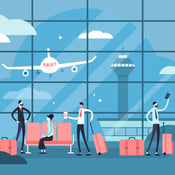Take your loyalty programme to new heights
-By Steve Arsenault
The success of loyalty programmes is undeniable.
Loyalty programmes were initially designed to influence travel behavior, enticing people to choose the sponsoring company even if it wasn’t the most convenient option. And they worked like a charm. Travellers often went out of their way to stick to their preferred programme, even overlooking more conveniently timed flights or better located hotels, all for the sake of accruing rewards and maintaining their status. They’re even more willing to forgive the occasional hiccup in service, preferring to give their chosen travel partner a second chance rather than incur the switching costs of moving to a new programme. A cottage industry of websites and blogs has sprung up to help travellers navigate the intricate world of loyalty programmes, which demonstrates just how much these programmes and benefits mean to travellers.
 To make their programmes even more attractive, travel companies have upped their game by expanding their partner networks. By offering a wide array of accrual and redemption partners, loyalty programmes can keep their members engaged even when they are not travelling.. Among these partners, cobrand credit cards have emerged as the real top performer, generating billions of dollars in revenue for the largest programmes. Cobrand cards have proven to be a reliable source of revenue, especially during the COVID-19 pandemic when travel came to a screeching halt. In several cases, these programmes, with market values in the billions of dollars, were pledged as collateral to secure financing and help U.S. airlines weather the storm.
To make their programmes even more attractive, travel companies have upped their game by expanding their partner networks. By offering a wide array of accrual and redemption partners, loyalty programmes can keep their members engaged even when they are not travelling.. Among these partners, cobrand credit cards have emerged as the real top performer, generating billions of dollars in revenue for the largest programmes. Cobrand cards have proven to be a reliable source of revenue, especially during the COVID-19 pandemic when travel came to a screeching halt. In several cases, these programmes, with market values in the billions of dollars, were pledged as collateral to secure financing and help U.S. airlines weather the storm.
It's safe to say that loyalty programmes have not just succeeded; they've transformed the travel industry. Does this phenomenal success mean that they should rest on their laurels? Or should they leverage this asset to drive even higher levels of customer engagement and profitability?
Real success comes from emotional loyalty.
Well, let me share some insider wisdom with you. Loyalty experts are making a compelling case that real success comes by shifting from programmatic loyalty to emotional loyalty. This shift may be particularly crucial in the travel industry, where many customers are at risk of losing their elite status post-pandemic. The so-called “status cliff” removes the barriers of moving to a new provider, freeing the customer to take their business elsewhere. This reduces the value of programmatic loyalty for a substantial number of high lifetime value customers.
A deep dive into the literature on emotional loyalty reveals not only some differences in approaches, but also a wealth of commonalities. A recent whitepaper from Marigold resonated with me. The author outlines the journey of moving from programmatic loyalty to emotional loyalty, which consists of three stages – Affinity, Attachment and Trust. True emotional loyalty, with all the perks associated with it – like higher spending, increased retention and advocacy – is achieved only in Trust, the final stage. In short, Customer Lifetime Value (CLV) is only maximized when we reach this stage.
What struck me in this article were some of the requirements to establish emotional loyalty. In the Attachment stage, customers expect you to understand them, value them and meet their expectations. The Trust stage requires Authenticity and Communication. And here’s the kicker, this can only happen if you communicate with your customers in their native language in a way that truly resonates with them. In other words, trust requires a show of respect, and effective communication is one of the most powerful ways to accomplish that.
What does this all mean for your loyalty programme?
Many loyalty programmes focus on Translation – the act of converting text from a source language to a target language – with the goal of making materials more widely accessible. When accuracy is paramount, like your member guide and programme rules, this approach may be enough. Here, accuracy is more important than tone of voice.
 However, if your aim is to build an emotional connection with your customers, you need to go beyond translation. Enter Transcreation – a way that empowers the translators and copywriters to translate more freely, preserving context, tone of voice and style. Transcreation ensures consistent branding across all languages and evokes the same emotions in your audience. And remember, it’s all about this emotional connection!
However, if your aim is to build an emotional connection with your customers, you need to go beyond translation. Enter Transcreation – a way that empowers the translators and copywriters to translate more freely, preserving context, tone of voice and style. Transcreation ensures consistent branding across all languages and evokes the same emotions in your audience. And remember, it’s all about this emotional connection!
This can be taken even further with Localization – a process performed by professional marketing translators. Localization takes into account cultural, functional and stylistic aspects, ensuring a seamless overall customer experience. This not only increases comfort but also builds trust – crucial elements in establishing attachment and emotional loyalty.
This is important to note: building emotional connections is not a job for machine translation and AI. While they each have their role, it’s vital to develop a coherent language strategy as part of your loyalty programme’s marketing plan. Trust me, the incremental revenue generated will far outweigh the costs!
Travel loyalty programmes have achieved remarkable success, but the journey doesn't end here. To truly thrive in today's competitive landscape, it's time to pivot towards emotional loyalty. Effective language strategies like transcreation and localization are your secret weapons to make that happen. So, let's take your loyalty programme to even greater heights!
Steve is a loyalty expert and consultant at Attached and boasts many years in the industry. If you have specific questions about the content in this blog or other loyalty topics, feel free to reach out to Steve or another Attached expert.


